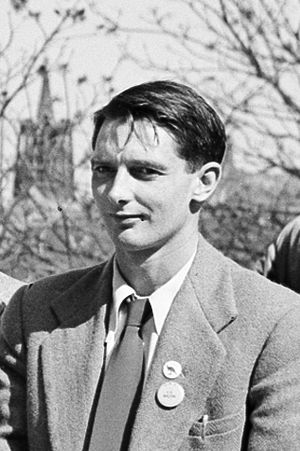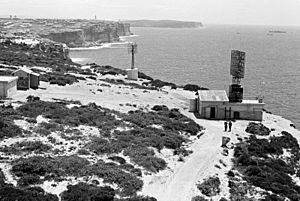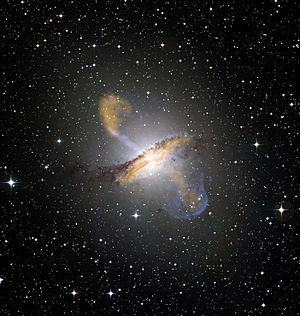John Gatenby Bolton facts for kids
Quick facts for kids
John Bolton
|
|
|---|---|
 |
|
| Born |
John Gatenby Bolton
5 June 1922 Sheffield, Yorkshire, England
|
| Died | 3 July 1993 (aged 71) Buderim, Queensland, Australia
|
| Alma mater | University of Cambridge |
| Known for | |
| Awards |
|
| Scientific career | |
| Fields | Astronomy, physics |
| Institutions | |
| Notable students |
|
John Gatenby Bolton (born June 5, 1922 – died July 6, 1993) was an amazing British-Australian astronomer. He helped create the field of radio astronomy. This is a way to study space by listening to radio waves from objects like stars and galaxies.
Bolton was important for figuring out that strong radio signals came from distant galaxies or the leftover parts of exploded stars, not just regular stars. He also helped discover quasars, which are super bright objects far away in space. He even helped find the center of our own galaxy, the Milky Way.
John Bolton was the first director of the famous Parkes radio telescope in Australia. He also started the Owens Valley Radio Observatory in California. Many of his students became leaders at other radio observatories around the world. One of them even won a Nobel Prize! Bolton is seen as a very important person in the history of astronomy in Australia.
Contents
Early Life and School
John Gatenby Bolton was born in Sheffield, United Kingdom, in 1922. His parents were both high school teachers. When he was young, John had some health problems like asthma and migraines.
But he was very good at sports, math, and science. He won a special scholarship to a school called King Edward VII School, Sheffield. In his last year there, he won the school's math prize.
In 1940, John went to Trinity College, Cambridge to study math and natural philosophy. Because of World War 2, his degree was shorter than usual. He decided to focus on physics. He finished his degree in 1942.
World War 2 and Radar Work
After college, Bolton joined the military. He chose the Navy because he loved ships. He became an officer and decided to work on radar for airplanes.
His time working with radar during World War 2 was very important for his future career. He learned a lot and met many people who would later become leaders in radio astronomy. One of these people was Martin Ryle.
Bolton worked on new radar systems for airplanes. He also became a radio officer on a British aircraft carrier called Unicorn. This job taught him a lot about electronics. It also gave him ideas for a special way to use radio antennas later on.
When World War 2 ended in 1945, Bolton was in Australia. He decided to stay in Sydney. The warm weather helped his health. Also, his application to study more at Cambridge University was turned down.
Discovering Radio Sources
After leaving the Navy, Bolton looked for a job in Australia. He found a position at the Radiophysics Laboratory of CSIRO. This lab was very good at radar technology.
Bolton first tried to study radio waves from sunspots. But the Sun was quiet at that time. He had heard that the Milky Way galaxy also gave off radio waves. He wondered if other stars might do the same.
Bolton and his friend Bruce Slee used two special antennas near the ocean in Sydney. They pointed the antennas towards the horizon. This created a "sea-cliff interferometer." It helped them get a much clearer view of radio sources.
This idea led to a big discovery! Bolton and another colleague, Gordon Stanley, found a very strong radio source in the constellation of Cygnus. They called it Cygnus A. They also found two weaker sources near Centaurus.
Their special setup gave them a much better view than anyone before. They confirmed that Cygnus A was a very small, bright radio source. This was the start of studying specific radio sources in space.
Finding "Radio Stars"
After finding Cygnus A, Bolton, Stanley, and Slee looked for more radio sources. By 1948, Bolton had found six new ones. He created a system for naming them based on their brightness in each constellation. This naming system is still used today for some bright radio sources.
Bolton showed that Cygnus A was not the only one. He found other famous radio sources like Taurus A, Centaurus A, and Hercules A. These sources were not connected to any bright stars that astronomers could see.
At first, many astronomers were doubtful. They didn't have good enough tools to confirm Bolton's findings. Also, these new discoveries didn't fit with what they already knew about space.
To convince everyone, Bolton worked to make his measurements more exact. He and Stanley went to New Zealand to make observations from both sides of the ocean. This helped them pinpoint the locations of the radio sources much better.
With better locations, Bolton could suggest what might be causing the radio waves. He showed that Taurus A was linked to the unusual Crab Nebula. He also linked Virgo A to a galaxy called Messier 87 that had a long, bright jet. And Centaurus A was linked to a strange object that astronomers were debating.
Bolton soon realized that Centaurus A and Virgo A were not strange objects inside our galaxy. They were actually very distant galaxies! This discovery in 1949 was very important. It helped start the study of radio sources outside our own galaxy. Many people think this was the most important paper Bolton ever wrote.
In 1950, Bolton visited astronomy labs in other countries. He met Fred Hoyle, a famous astrophysicist, and they became lifelong friends.
Back in Australia, Bolton decided to build a bigger radio telescope. They built a 72-foot dish at Dover Heights, New South Wales. In 1953, Bolton used it to map the Milky Way. He found the very center of our galaxy, called Sagittarius A.
Bolton wanted to build an even bigger telescope. But the lab decided to build a different type of telescope instead. This led to some disagreements. So, Bolton took a break from radio astronomy and worked on studying clouds.
But soon, he got an offer to start a new radio astronomy group in California. In 1954, Bolton accepted the job at Caltech.
Building Owens Valley Observatory
At Caltech, Bolton started the American radio astronomy program. He found a great spot for an observatory called Owens Valley. It was surrounded by mountains that blocked radio interference from cities.
Bolton wanted to build a telescope that could find the exact locations of radio sources. He also wanted it to see their detailed shapes. He led the building of an interferometer with two large 90-foot antennas.
This instrument was very successful. It helped many American radio astronomers learn and grow. It also became a model for future telescopes like the Very Large Array. One of its first discoveries was finding radio waves coming from the planet Jupiter! This brought a lot of attention to the observatory.
Because of his success, Bolton became a full professor. He also received a PhD from Caltech.
The Owens Valley telescope was so good that Bolton and his team started finding radio sources that were still a mystery. They looked at one source, 3C295, with optical telescopes. They found it was a galaxy incredibly far away, doubling the known distance to any object in the Universe! This discovery set the path for Bolton's future work.
Even with all his success, Bolton had agreed to return to Australia when a giant radio telescope was being built there. Also, the air pollution in California was bad for his health. So, in 1960, Bolton and his family moved back to Australia.
Parkes and Quasars
Bolton arrived in Parkes, Australia, where a huge new radio telescope was being built. It was a 64-meter dish. Bolton had already helped with the design. Now, he was in charge of building it and getting it ready to use. He also became the first director of the telescope.
The Parkes radio telescope was finished on time. It quickly made two important discoveries. First, it confirmed that radio waves from Centaurus A and Vela X were "polarized." This showed that the radio waves were made by a process called synchrotron emission.
Second, and even more important, Parkes found something called Faraday rotation in polarized radio sources. This was the first time scientists had seen this in space. It proved that our Milky Way galaxy has a magnetic field.
Bolton's biggest scientific contribution with Parkes was the discovery of quasars. He had already worked on finding optical sources for radio galaxies at Caltech. Now, evidence showed there was a new type of active galaxy. These were 100 times brighter than the brightest galaxies known before.
Bolton was actually the first to correctly figure out how incredibly far away one of these objects, 3C48, was. This was two years before it was officially published in 1962. The Parkes telescope, led by Bolton, regularly found the most distant objects known in the Universe at that time.
After the first quasars were found, Bolton spent most of the 1960s mapping the southern sky with Parkes. He looked for new radio sources and tried to find their optical counterparts. He worked closely with optical astronomers at Palomar and Lick Observatories.
During this time, Bolton was asked to lead important government groups and give major speeches. In the 1960s, he also became a member of the Australian Academy of Science.
Parkes and the Apollo 11 Moon Landing
As director of Parkes, Bolton also played a part in the Apollo 11 Moon landing. NASA asked CSIRO if Parkes could help with their Deep Space Network. Bolton was very eager to help. He felt Parkes owed a lot to NASA and the US for their help in building the telescope.
NASA wanted Parkes to be a backup in case the moonwalk was delayed or if their own tracking stations had problems. Bolton and his team made sure the telescope was ready. Because the moonwalk schedule changed, NASA received TV signals from three places: Goldstone, Honeysuckle Creek, and Parkes.
NASA used the signal from Parkes for most of the moonwalk. The movie The Dish (released in 2000) tells the story of how Parkes and Bolton helped with the Apollo 11 Moon landing. Bolton made sure Parkes helped track all the Apollo missions.
Later Years and Awards
Bolton stepped down as Parkes director in 1971. He wanted to focus more on his science. He continued to study radio sources and find their optical matches. One important discovery from this time was a special source called PKS B1934-638.
In 1973, Bolton was elected to the Royal Society of London. He also became a vice-president of the International Astronomical Union. In 1977, he received the Gold Medal of the Royal Astronomical Society for his amazing work in astronomy.
John Bolton passed away in 1993 after having several heart attacks.
Awards and Recognition
John Bolton received many important awards, including:
- 1951: Edgeworth David Medal (Australia)
- 1967: First Karl Jansky Lecturer (U.S.)
- 1977: Gold Medal of the Royal Astronomical Society
- 1982: Commander of the Order of the British Empire (CBE)
- 1988: Bruce Medal of the Astronomical Society of the Pacific (U.S.)




